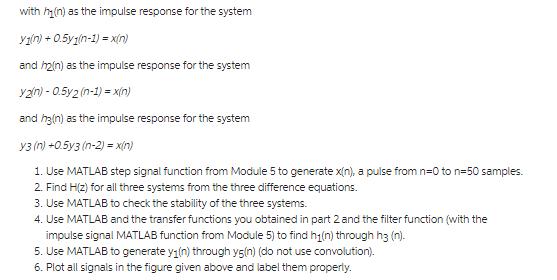Answered step by step
Verified Expert Solution
Question
1 Approved Answer
with hi(n) as the impulse response for the system y1(n) + 0.5y1(n-1) = x(n) and 2(n) as the impulse response for the system y2(n)


with hi(n) as the impulse response for the system y1(n) + 0.5y1(n-1) = x(n) and 2(n) as the impulse response for the system y2(n) - 0.5y2 (n-1)= x(n) and hg(n) as the impulse response for the system y3 (n) +0.5y3 (n-2) = x(n) 1. Use MATLAB step signal function from Module 5 to generate x(n), a pulse from n=0 to n-50 samples. 2. Find H(z) for all three systems from the three difference equations. 3. Use MATLAB to check the stability of the three systems. 4. Use MATLAB and the transfer functions you obtained in part 2 and the filter function (with the impulse signal MATLAB function from Module 5) to find h(n) through h3 (n). 5. Use MATLAB to generate y(n) through yg(n) (do not use convolution). 6. Plot all signals in the figure given above and label them properly. x(n) h (n) h (n) Y(n) Y(n) h(n) h (n) h (n) Y4(n) Y5 (n) Y3(n) y(n)
Step by Step Solution
★★★★★
3.32 Rating (140 Votes )
There are 3 Steps involved in it
Step: 1

Get Instant Access to Expert-Tailored Solutions
See step-by-step solutions with expert insights and AI powered tools for academic success
Step: 2

Step: 3

Ace Your Homework with AI
Get the answers you need in no time with our AI-driven, step-by-step assistance
Get Started


